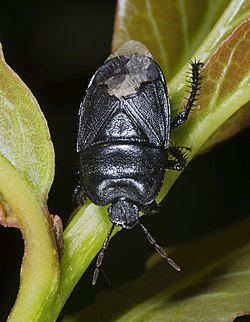| Cydnidae Temporal range: [1] | |
|---|---|
 | |
| Cydnus aterrimus Type genus for the family | |
| Scientific classification | |
| Kingdom: | Animalia |
| Phylum: | Arthropoda |
| Class: | Insecta |
| Order: | Hemiptera |
| Suborder: | Heteroptera |
| Superfamily: | Pentatomoidea |
| Family: | Cydnidae Billberg, 1820 |
Cydnidae are a family of pentatomoid bugs, known by common names including burrowing bugs or burrower bugs. [2] As the common name would suggest, many members of the group live a subterranean lifestyle, burrowing into soil using their head and forelegs, only emerging to mate and then laying their eggs in soil. Other members of the group are not burrowers, and live above the soil layer, often in close association with plants. Several species are known as agricultural pests. [3]